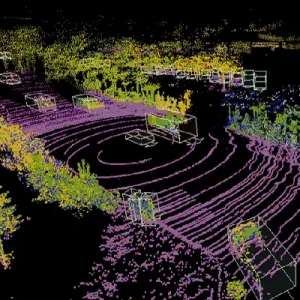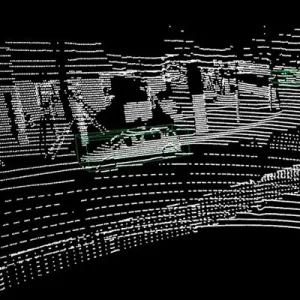3D Annotation Services
Your Partner in Spatial Intelligence
We are The Human Insight Behind 3D Perception We offer 3D point cloud labeling & Multi-sensor labeling (3D / 2D fusion) with high accuracy, super quick turnaround time, highly competitive prices and respected deadline.
PARTNERSHIP WITH THE BEST TOOLS
Oworkers > Data Annotation Services > 3D Annotation Services
Unlocking AI Potential with
3D Annotation Services

3D annotation services represent the cutting edge of AI development, enabling machines to understand and interact with the three-dimensional world. These specialized services transform complex spatial data into structured information that powers autonomous vehicles, advanced robotics, and immersive technologies.
As AI systems expand globally, partnering with a trusted outsourcing provider like oworkers for your high-quality 3D annotation has become critical for companies developing next-generation perception systems.
Find more information about our data annotation service company
3D Annotation services Transform Raw Data into Intelligent Systems
3D annotation companies bridge raw three-dimensional data and AI-powered systems. Unlike 2D annotation, 3D annotation services involves labeling spatial information, including depth, volume, and orientation.
This process converts point clouds, LiDAR scans, and 3D images into structured datasets that machine learning algorithms can learn from. Many organizations choose to outsource to specialized 3D annotation providers to manage these complex tasks efficiently and cost-effectively.
Skilled annotators identify and label objects within 3D space, adding semantic meaning to otherwise indecipherable data points. Through precise marking with 3D bounding boxes, polygons, and segmentation, they create the foundation for autonomous systems to understand the physical world — a level of precision that trusted outsourcing partners help deliver at scale.
The Evolution of 3D Annotation Techniques
The field of 3D annotation has evolved rapidly alongside advancements in computer vision and spatial computing. Earlier methods relied on basic cuboid annotations, but today’s 3D annotation services encompass sophisticated techniques including :
3D Cuboid/Bounding Box Annotation
Creating three-dimensional containers around objects
3D Point Cloud Segmentation
Classifying individual points within a point cloud
3D Polygon Annotation
Drawing precise boundaries around irregularly shaped objects
3D Semantic Segmentation
Assigning class labels to every point in a 3D scene
3D Instance Segmentation
Differentiating between multiple instances of the same object class
These advanced techniques allow for the annotation of complex environments with overlapping objects and varying occlusion levels. Modern 3D annotation tools now support real-time collaboration across teams working in different languages, making global AI development more efficient.
Strategic Considerations for
Your 3D Annotation Partnership

Balancing Technical Sophistication with Human Expertise
When selecting a 3D annotation partner, sophisticated annotation tools are valuable only when paired with human expertise. Effective 3D annotation services combine advanced platforms partners with our experienced annotators trained in 3D perception.
This balanced approach ensures that technical capabilities are leveraged through human judgment, resulting in higher-quality training data.
Data Security FOR 3D InnovatORS
3D datasets often contain sensitive information about environments, infrastructure, or proprietary technology. A trustworthy provider should demonstrate strong security credentials through ISO 27001 certification, GDPR compliance, secure data transfer protocols, and clear data handling policies.


Optimizing YOUR COST for 3D labeling project
The cost structure of 3D annotation varies based on complexity, volume, and quality requirements. To optimize your cost, oworkers had based his Delivery centers in offshore countries (Bulgaria, Madagascar and Egypt) Allow you to save up to 70 % without compromising the quality
High-quality annotations often prevent costly rework, making it important to choose a provider that balances efficiency with precision, usually we are doing a POC (Proof Of Concept) to prove that we can do it but also cause we need to be sure about the pricing we offer.
OUR UNIQUE LOCATIONS
We have our own 3 delivery centers in 3 countries : Bulgaria, Madagascar and Egypt , who allows us to deliver in Multi Languages, to offer back up plan and to offer super affordable rate and Flexibility in term of ramp up and ramp down.


HIGH RETENTION RATE + SOCIAL IMPACT
We have an astonishing 98 %+ in employee retention rate compared to 15 % in the industry average + We have a huge social impact on the cities where we operate.
Overcoming the Complexity Barrier
in 3D Annotation
Instruction tuning involves creating pairs of instructions and desired outputs to fine-tune LLMs for specific tasks or behaviors.
This approach helps models understand and follow natural language instructions more effectively.

Navigating Spatial Challenges in Three-Dimensional Data
3D annotation companies face unique challenges due to the inherent complexity of three-dimensional data. Unlike 2D annotation, which operates on flat images, 3D annotation must account for:
- Multiple viewpoints and perspectives
- Varying densities of point cloud data
- Occlusion and partial visibility of objects
- Accurate representation of object orientation and pose
- Integration of data from different sensors and sources
- Often 3D-2D fusion needs
These challenges require specialized expertise and tools that go beyond standard annotation capabilities, with professional services employing sophisticated software platforms designed specifically for 3D data.
Ensuring Precision
Precision and QA (Quality assurance) are critical when projects require coordination across global teams. Effective 3D annotation services provide standardized frameworks and strong QA assurance processes.
Scaling 3D Annotation for Enterprise-Level Datasets
Training robust AI models requires massive volumes of properly annotated 3D data. Scaling annotation presents challenges in managing teams, maintaining quality, and balancing speed with precision. Enterprise-grade 3D annotation services implement quality assurance processes and scalable workflows to ensure consistent results even at high volumes.

Beyond Autonomous Vehicles
Diverse Applications of 3D Annotation
While autonomous vehicles represent the most visible application of
3D annotation services, with LIDAR annotation the technology’s reach
extends across numerous industries:

Geospatial and Urban Planning
This sector uses 3D point cloud data for creating detailed city models, mapping terrain, and analyzing infrastructure. This information is vital for urban planning, environmental monitoring, and managing natural resources

Agriculture
The agriculture industry utilizes 3D point cloud annotation for precision farming. By analyzing 3D data from drones and other sensors, farmers can monitor crop health, optimize irrigation, and identify areas that need fertilizer, leading to increased yields and reduced costs.

Autonomous Vehicles
This is arguably the most significant and demanding industry for 3D point cloud annotation. Self-driving cars rely on LiDAR technology to create a real-time 3D map of their surroundings, and this data must be meticulously annotated to identify pedestrians, other vehicles, traffic signs, and road boundaries. Accurate annotation is critical for the safety and functionality of autonomous driving systems.

Robotics and Manufacturing
In manufacturing, 3D point cloud data is used for tasks like automated quality inspection, robot navigation, and inventory management in warehouses. By creating precise 3D models of factory floors and components, companies can optimize production processes and improve efficiency.

Smart Cities
Powering urban planning and infrastructure development through annotated 3D mapping, Geospacial annotations.

Architecture and Construction
Facilitating building information modeling and site monitoring

Healthcare
In the medical field, 3D point cloud data is used for creating detailed models of organs and bones, which can be used for surgical planning and creating custom prosthetics.

Augmented and Virtual Reality
Creating realistic virtual environments with properly labeled spatial elements
The expansion of 3D annotation into these diverse fields highlights its importance to spatial AI applications
across the global economy, with each industry benefiting from the precision that 3D annotation companies provide.
Our clients include
Autonomous Vehicle Companies
These are major clients, ranging from established automotive manufacturers to tech startups developing self-driving technology. They require massive volumes of accurately annotated LiDAR data to train and validate their autonomous driving models.
AI and Machine Learning Companies
Companies specializing in AI and ML development are key clients. They often require annotated 3D data for a wide range of applications, including object recognition, scene understanding, and augmented reality.
Robotics and Automation Companies
This includes companies that design and build robots for various applications, from manufacturing and logistics to healthcare and exploration. They need annotated 3D data to enable their robots to navigate and interact with their environment safely and effectively.
Geospatial and Surveying Firms
These companies provide mapping and surveying services to various sectors, including construction, urban planning, and environmental management. They require annotated 3D point cloud data to create accurate and detailed maps and models.
Academic and Research Institutions
Researchers in fields like computer vision, robotics, and environmental science use annotated 3D data to develop and test new algorithms and theories.
Government Agencies
Government bodies, including those involved in transportation, defense, and urban planning, are also significant clients. They use 3D point cloud data for infrastructure management, security, and environmental monitoring.
FAQ
Which emerging industries are leveraging 3D annotation services?
How do annotation requirements differ between 2D and 3D environments?
What determines the timeframe and cost of 3D annotation projects?
Beyond established fields like autonomous vehicles and robotics, 3D annotation services now support drone navigation, precision agriculture, digital twins for manufacturing, immersive entertainment, and spatial computing for retail environments.
Any industry requiring spatial understanding in three-dimensional space can benefit from professional 3D annotation.
3D annotation services address more complex data structures than 2D annotation, accounting for depth, orientation, and spatial positioning.
Of course for some projets we need to do 2D 3D fusion, This requires specialized tools and annotators with strong spatial reasoning abilities, typically resulting in different pricing models and turnaround expectations.
Project complexity, number of object classes, annotation granularity, data volume, and quality requirements all impact timeframe and cost. Working with an experienced provider like OWorkers helps optimize these factors for your specific application needs and budget constraints.
Start Your AI Journey with Expert 3D Annotation
When you choose OWorkers for your 3d annotation services, you gain a strategic partner committed to your AI success.
Contact us today to discover how our ethical, secure, and cost-effective annotation services can accelerate your AI development journey.

